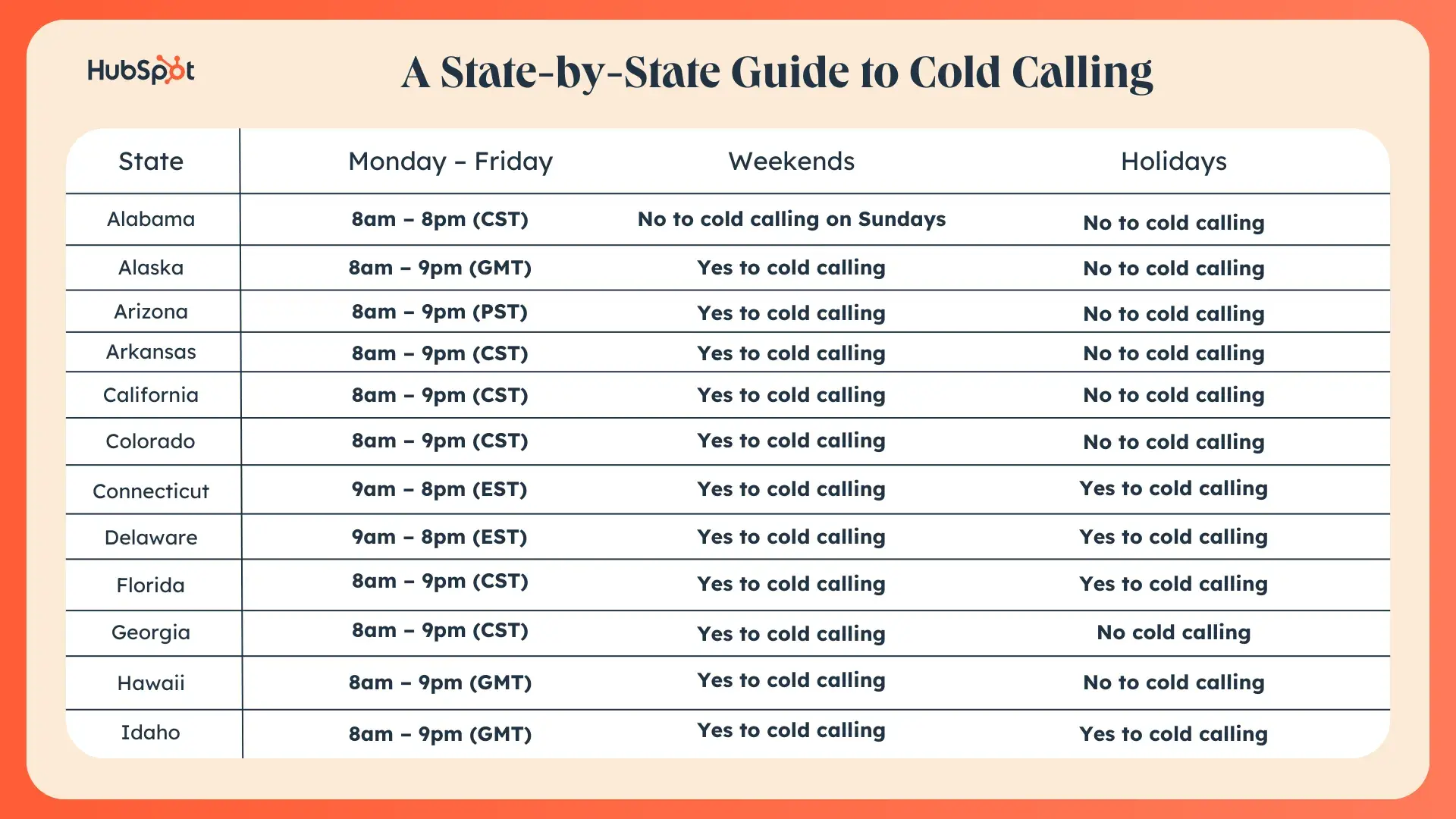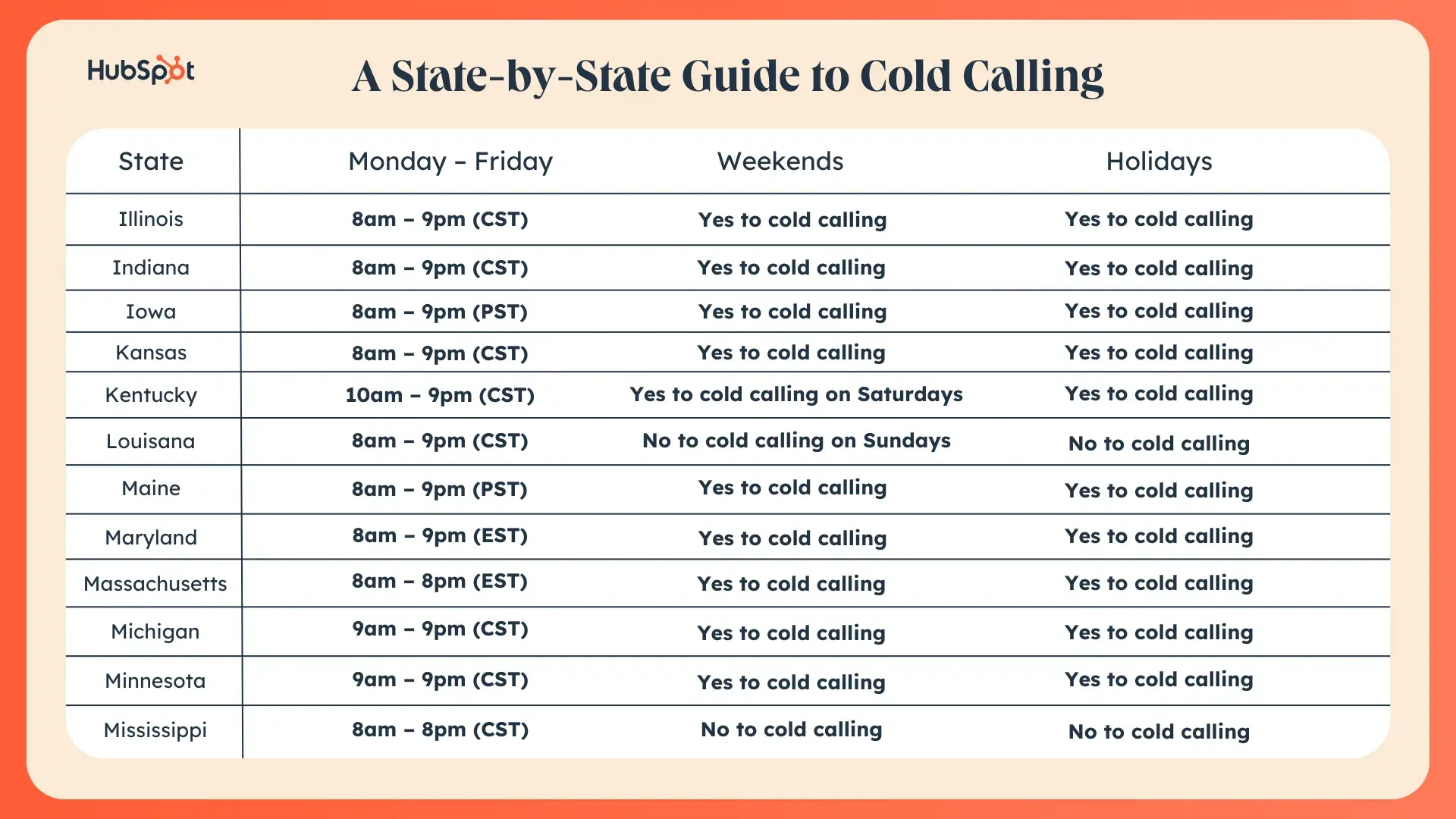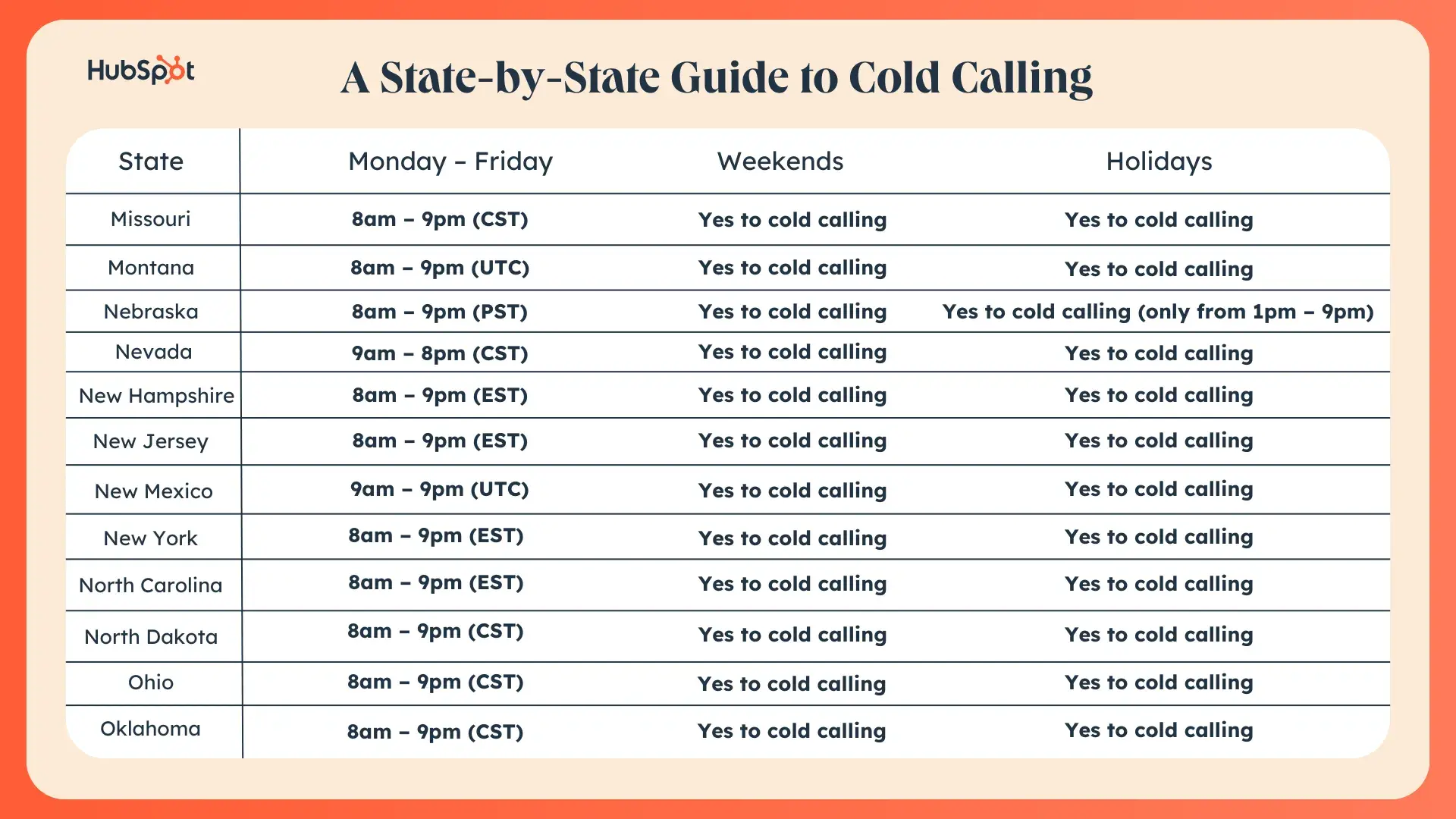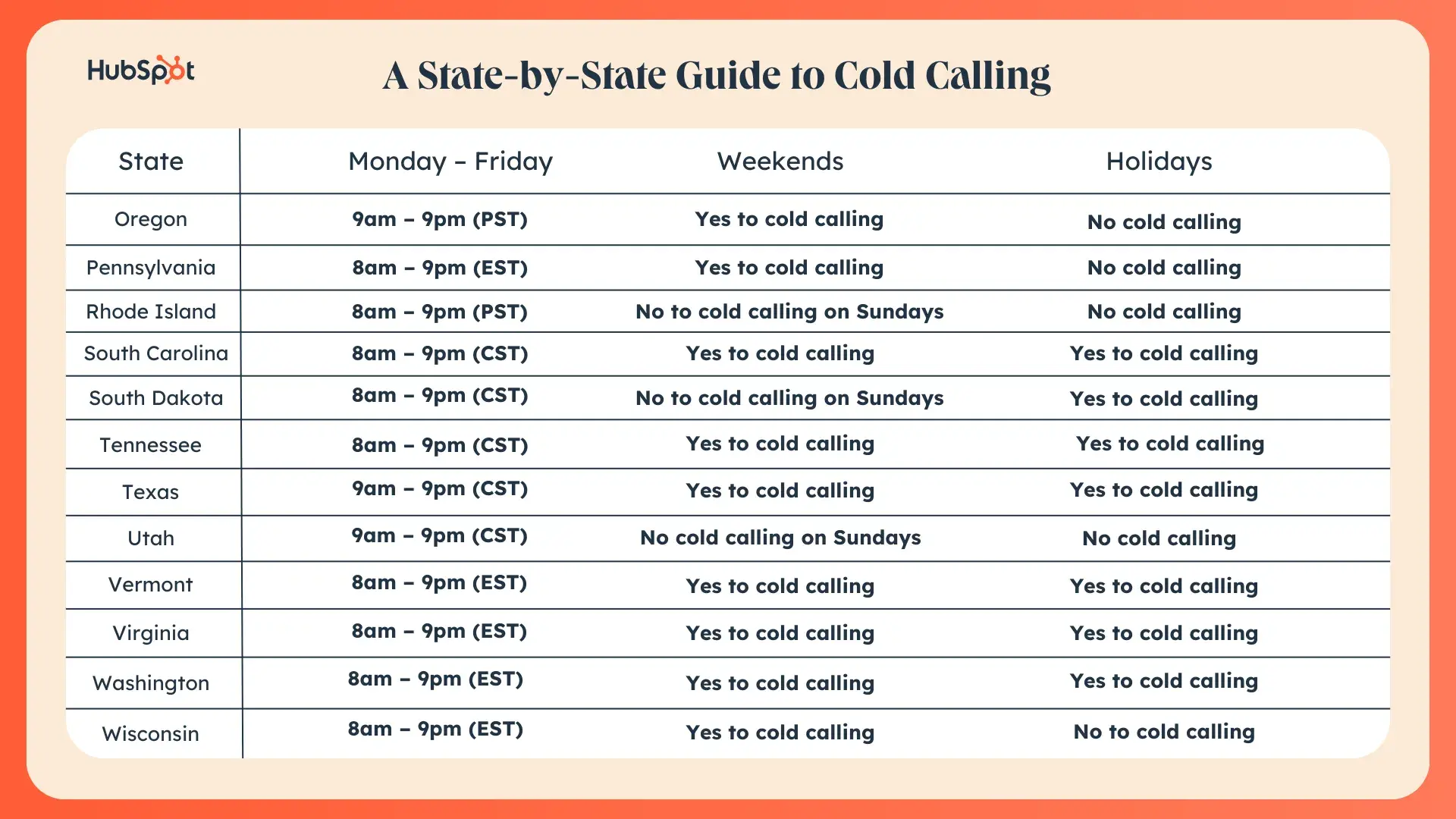You might've heard a few horror stories about aggressive cold callers who disrupt people’s dinners or spam their phones. Maybe you’ve done this yourself (there’s no shame in the sales rep game, though). But these days, there’s been quite a bit of discourse circulating regarding whether or not cold calling is even a legal method anymore.
In this post, I’m going to finally set the record straight. Additionally, I’ll dive into important cold calling laws and regulations in the United States, talk about need-to-know cold calling etiquette, and provide some standard cold calling tips for all you sales folks (to ensure your cold calls are not only compliant but maybe slightly less infuriating).
Let’s get started, shall we?
Table of Contents:
- Is Cold Calling Illegal?
- Telephone Protection Consumer Act (TPCA)
- The Telemarketing Sales Rule (TSR) Explained
- Best Practices for Cold Calling in Non-U.S. Regions
- Telemarketing Etiquette Every Salesperson Should Know
- B2B vs. B2C Cold Calling Best Practices
- Stay Compliant, Stay Successful
Is cold calling illegal?
Cold calling is legal in most places, it remains a legitimate practice within the realms of ethical sales and marketing strategies. However, in some regions, there are strict regulations and guidelines in place to ensure that businesses respect the privacy and preferences of folks on the receiving end.
Here’s a more detailed overview of additional restrictions, systems, and rules put in place to combat illicit practices around cold calling in the U.S., that all telemarketers should know about before picking up the phone:
As of 2023, the U.S. National Do Not Call Registry contained over 249 million actively registered phone numbers, highlighting the vast number of consumers who prefer not to receive unsolicited calls.
In 2023 alone, the Federal Trade Commission reported approximately more than 2 million Do Not Call complaints, emphasizing the importance of adherence to its regulations. Clearly, abiding by the FTC’s rules is the easiest way to avoid the risk of becoming a telemarketing villain.
Penalties and Fines
If you do bad, you pay the price. Businesses found in violation of the Telemarketing Sales Rule (which I’ll share more about later on) can face fines of up to $51,744 per incident.
Of these many strict regulations and guidelines (for the U.S.), the Telephone Protection Consumer Act (TPCA), which I’ll discuss and define in greater detail next, is one of the most impactful and influential laws ratified in relation to cold calling.
Telephone Protection Consumer Act (TPCA)
The Telephone Protection Consumer Act (TCPA) is a set of rules created by the Federal Communications Commission (FCC) to protect likely clients from intrusive telemarketing calls. This law was implemented to ensure consumers aren’t bombarded with unsolicited phone calls, text messages, or even faxes (and yes, before you ask, faxes are still being sent in 2024).
The TCPA has been around awhile; since its inception, its range of restrictions has changed over the years. Some of its updated guidelines for cold calling include obtaining prior consent, registering with the National Do Not Call Registry, and prohibiting automated dialing systems.
But for a more big-picture look at the TPCA, check out the image below for a full timeline of its evolution:

Now, if a company violates the TCPA, they will likely face the following penalties:
- For unintentional violations: Fines can be up to $500 per violation.
- For willful or knowing violations: Fines can be up to $1,500 per violation.
- For violations involving automatic dialing systems (ATDS): Fines can be up to $1,500 per violation, and if the violation is willful or knowing, the fine can be up to $2,500 per violation.
I’ll also note that those numbers above are maximum fines, so the actual amount may be lower depending on the actual offense and how frequently it’s happened. However, even smaller fines can add up quickly, especially for repeat offenders.
All of this said, here’s what telemarketers should know about navigating the TCPA while completing cold calls:
1. Prior Express Written Consent
This is a critical requirement for making calls using auto-dialers or sending text messages. Without prior express written consent, telemarketers could face significant penalties. Consent can be obtained through a signed written document, a recorded phone call, or an electronic signature.
2. Do Not Call Registry Compliance
Verify that numbers are not on the National Do Not Call Registry before making calls. Telemarketers should regularly check the National Do Not Call Registry for updates and ensure their calling lists are scrubbed accordingly.
3. Time and Repetitive Call Restrictions
Be mindful of different time zones when making calls, especially to consumers in other regions. Additionally, adhere to the specified time restrictions and avoid making excessive calls to the same consumer.
4. Call Recording
Keep it real with your customers. Inform them that their calls may be recorded and explain the purpose of recording, such as for quality assurance or training purposes.
5. Compliance Training
Telemarketers’ calls should be monitored to ensure compliance with TCPA regulations. Plus, maintaining records of training sessions and employee certifications are always good to have handy.
Telemarketing Sales Rule (TSR) Explained
Earlier, I mentioned the big, scary Telemarketing Sales Rule (TSR). Well, I have news for you: It’s actually not that big, or scary, but it is something that all salespeople should take quite seriously.
Similarly to the TCPA, the TSR aims to protect consumers from unwanted telemarketing calls. The only difference between the TCPA and the TSR is that one’s a broader set of laws on all telemarketing activities (TCPA) and the other has a more specific look at human accountability in telemarketing (TSR).
Consider the TSR a telemarketer’s bible and the TCPA a customer’s safeguard. They work hand-in-hand but are inherently different.
Best Practices for Cold Calling in Non-U.S. Regions
Now that I’ve covered the basics for standard cold calling practices in the U.S., let’s shift gears a bit and talk about general cold calling etiquette for non-U.S. regions.
While the core principles of cold calling remain relatively consistent across the globe, cultural nuances and regional differences do significantly impact the effectiveness of your sales approach.
In short, here are a few key considerations to think about if you’ll be cold calling outside of the U.S.:
1. European Regions
In European territories, folks often appreciate a more to-the-point approach, so striking a balance between directness and politeness in your telemarketing pitch is crucial if you’re planning to place a call across the pond.
2. Asian-Pacific Regions
In many Asian countries and cultures, privacy and formal communication are extremely important.
That said, if you’re a salesperson with business in the Asian-Pacific region and you’ve got to make some cold calls, take some time to outline a strategy for maintaining respectful interactions. It’ll take you a long way, especially as you could be cold calling more international customers in the future.
3. Latin America
Latin American cultures often value warmth and friendliness. If you happen to be making some cold calls to places like Portugal or Colombia, be sure to showcase genuine interest in the person you’re speaking with. Ask your prospect how their day was, what they’re up to, even if they have a moment to chat with you (and if not, just call back at another time).
Building this rapport helps create a more comfortable atmosphere, especially if you’re planning to introduce information about a product to them.
Oh, and think about brushing up on some of those conversational Spanish speaking skills from high school, too. They just might help you out here.
4. Canada
Believe it or not, Canadians, just like us American folk, are generally busy people. When making cold calls to Canada, it’s crucial to respect their time.
Try to keep your calls brief and to the point, and be mindful of the time of day you‘re calling. Avoid calling people during peak business hours or when they’re likely to be busy with other commitments.
Telemarketing Etiquette Every Salesperson Should Know
Telemarketing has always been the standard way to reach customers but only when it’s done right. That said, it’s important to follow specific guidelines and rules to ensure that telemarketing is done properly, successfully, and effectively.
Here are some telemarketing rules that I suggest all sales reps follow, especially to close deals with ease:
1. Don’t call numbers on the Do Not Call Registry.
This is a federal registry of phone numbers that have opted out of receiving telemarketing calls. Always check the registry before cold-calling any numbers.
2. Stick to the hours.
There are specific hours for when you can make telemarketing calls. Generally, you can’t call before 8 A.M. or after 9 P.M. local time. Here’s a detailed list of all hours that allow telemarketing calls:




3. Identify yourself clearly.
Make sure the caller ID shows your name, location, and business. Don’t use misleading or anonymous numbers.
4. Provide an opt-out option.
Don’t hold your customers hostage. Let them know they can opt out of receiving future calls at any time.
5. Share accurate and honest information.
Provide accurate information about the product or service you are offering. Clearly explain any terms, conditions, costs, and refund policies associated with the offer.
6. Keep records of all calls.
Keep detailed records of all telemarketing transactions and interactions. This should include call logs, consent forms, and any other relevant documentation.
7. Avoid unfair practices.
Simply put: Don’t be that one telemarketer. Using high-pressure sales tactics or harassment to coerce a sale is way outdated. Trust me, you’ll lose prospects entirely before you can even secure them.
B2B vs. B2C Cold Calling Best Practices
Clearly, cold calling has indeed changed a lot over the years. Back in the day, it used to be acceptable (and somewhat expected) to be a bit pushy with your leads over the phone.
This behavior is no longer acceptable. Cold calling, however, especially for modern B2B and B2C sales and marketing efforts, is. And despite new-fangled ways to reach customers, it’s still pretty darn effective. Allow me to explain.
In recent data from our 2024 State of Customer Service Report and Consumer Trends Report, it was found that 93% of customer service reps say phone-based customer service is somewhat/very effective. Moreover, 49% of consumers agreed that phone calling is one of their top three preferred methods for reaching a salesperson/customer service rep.
When it comes to B2B versus. B2C cold calling, the rules for each are quite different. But once you understand the distinctions between the two, you’ll be a pro in no time.
To help you better understand how the two differ, take a look at the breakdown below:
B2B Cold Calling
Here’s how I suggest telemarketers should handle B2C cold calling:
- Target decision-makers as customers. With B2B cold calling, you’re typically reaching out to the person who can make the decision to purchase your product or service. Use LinkedIn, company websites, and other resources to identify the key decision-makers within your target market.
- Be prepared to discuss your product and service in depth. You should be able to articulate the benefits of your product or service and how it can solve the customer’s problems.
- Focus on building relationships. B2B sales is often about building relationships with your customers. Take the time to get to know their business, its mission, and their needs.
B2C Cold Calling
Here’s how I suggest telemarketers should handle B2B cold calling:
- Have a strong value proposition. Be able to clearly articulate the benefits of your product or service to the customer. Understanding your product or service inside and out, including its unique features, helps convey how it solves for your customers.
- Use conversational tone. Talk to the customer like you would a friend. Using the customer’s name and referencing their specific needs or interests goes a long way.
- Be prepared to handle objections. Anticipate common objections (or lots of follow-up questions) and have answers ready. A well-crafted script can provide a framework for handling objections while still allowing for flexibility and personalization.
Stay Compliant, Stay Successful
So, there you have it! Cold calling is still a viable sales tactic, but it’s important to do it the right way. By understanding and following the laws and regulations, you can avoid legal trouble and build trust with potential customers.
Remember: The overall goal here is to be respectful of people’s time and privacy. If you follow these tips, you’ll be well on your way to successful and legal cold calling.
And hey, who knows? You might just close a few more deals.
Cold Calling





![How & why to use sales scripts [+ 14 examples and templates]](https://53.fs1.hubspotusercontent-na1.net/hubfs/53/sales-script-examples-hero.webp)


![HubSpot's 2025 State of Cold Calling Report [Data From 350+ Sales Professionals]](https://53.fs1.hubspotusercontent-na1.net/hubfs/53/state-of-cold-calling-1-20250403-7698219.webp)



![8 Cold Calling Openings to Use [+ Script Templates for Sales Pros]](https://53.fs1.hubspotusercontent-na1.net/hubfs/53/how-to-open-a-cold-call-1-20241107-6511492.webp)